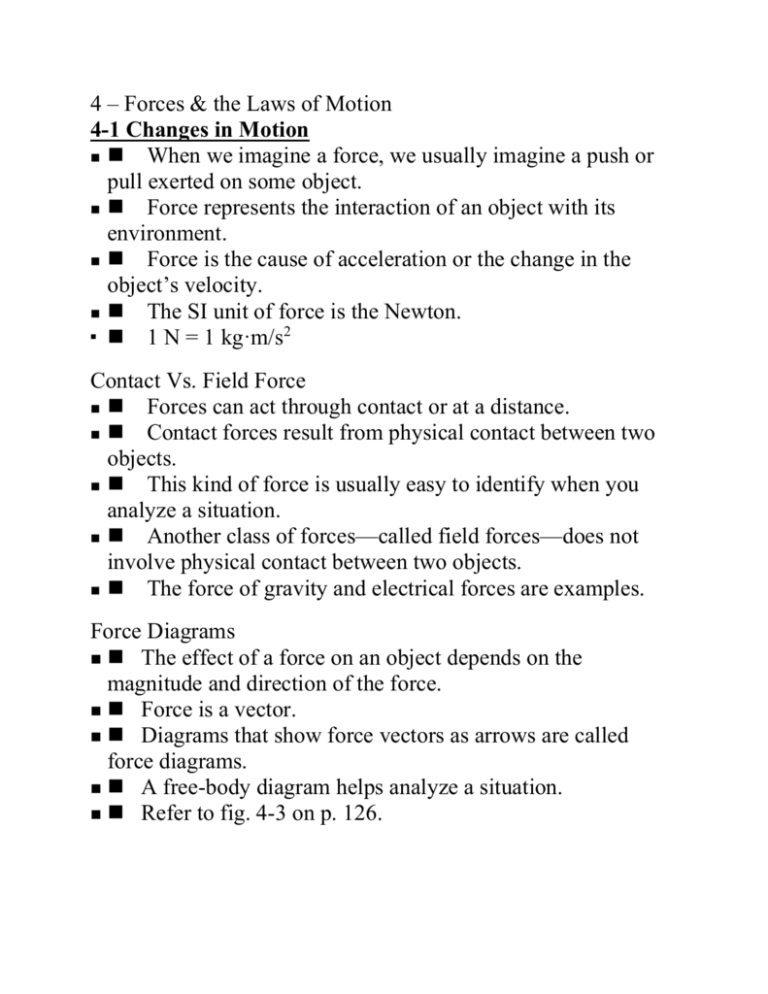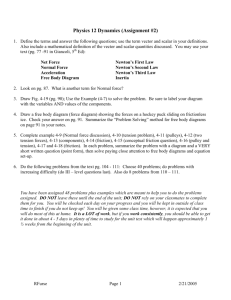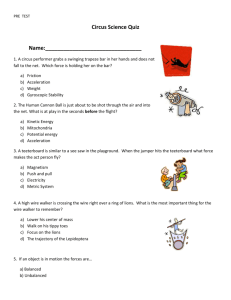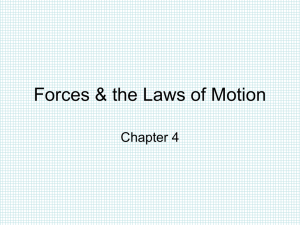4 – Forces & the Laws of Motion
advertisement

4 – Forces & the Laws of Motion 4-1 Changes in Motion When we imagine a force, we usually imagine a push or pull exerted on some object. Force represents the interaction of an object with its environment. Force is the cause of acceleration or the change in the object’s velocity. The SI unit of force is the Newton. 1 N = 1 kg·m/s2 Contact Vs. Field Force Forces can act through contact or at a distance. Contact forces result from physical contact between two objects. This kind of force is usually easy to identify when you analyze a situation. Another class of forces—called field forces—does not involve physical contact between two objects. The force of gravity and electrical forces are examples. Force Diagrams The effect of a force on an object depends on the magnitude and direction of the force. Force is a vector. Diagrams that show force vectors as arrows are called force diagrams. A free-body diagram helps analyze a situation. Refer to fig. 4-3 on p. 126. Free-body Diagrams Free-body diagrams isolate an object and the forces acting on it. Figure 4-4 on p. 127, 128 illustrates the steps for drawing a free-body diagram. 4-2 Newton’s First Law An object at rest remains at rest, and an object in motion continues in motion with constant velocity (that is, constant speed in a straight line) unless the object experiences a net external force. Inertia is the tendency of an object not to accelerate. In other words, when the net external force on an object is zero, its acceleration is zero. Net External Force Acceleration is determined by net external force. The net external force is the vector sum of all the forces acting on an object. When all external forces acting on an object are known, the net external force can be found using the methods for finding resultant vectors. Tug-of-war is a good example of net forces. Refer to sample and practice 4A on pp. 132, 133. Mass & Inertia Mass is a measurement of inertia. The inertia of an object is proportional to its mass. Seatbelts are placed in cars because of the laws of inertia and holds the passenger firmly in place in the event of a collision. A seat belt may also lock when a car rapidly slows down or turns a corner. Fig. 4-14 illustrates how one type of shoulder harness operates. Equilibrium Objects that are either at rest or moving with constant velocity are said to be at equilibrium. The force that brings an accelerating object into equilibrium must be equal and opposite to the force causing the object to accelerate. An object is in equilibrium when the vector sum of the forces acting on it is equal to zero. 4-3 Newton’s 2nd and 3rd Laws Force is proportional to mass and acceleration. Newton’s 2nd law – the acceleration of an object is directly proportional to the net external force acting on the object and inversely proportional to the object’s mass. Fnet = F = ma where “a” is the acceleration in m/s2, “m” is the mass in kg, and F represents the vector sum of all external forces acting on the object. Refer to sample and practice 4B on pp. 137, 138. Newton’s 3rd Law Forces always exist in pairs. rd Newton’s 3 law – if two objects interact, the magnitude of the force exerted on object 1 by object 2 is equal to the magnitude of the force simultaneously exerted on object 2 by object 1, and these two forces are opposite in direction. In other words, for every action there is an equal and opposite reaction. An action-reaction pair is a pair of simultaneous equal but opposite forces resulting from the interaction of two objects. Action and reaction forces each act on different objects. Field forces also act in pairs. 4-4 Everyday Forces The force of gravity exerted on the ball by Earth, Fg, is a vector quantity, directed toward the center of Earth. The magnitude of this force, Fg, is a scalar quantity called weight. When the mass and the acceleration due to gravity are known, the weight of an object can be calculated using Fg = mg where g = 9.81 m/s2. The Normal Force A force exerted by one object on another in a direction perpendicular to the surface of contact is a normal force. FN = mgcos where represents the angle between the normal force and a vertical line, and also the angle between the contact surface and a horizontal line. The normal force is always perpendicular, but is not always opposite in direction to the force of gravity. The Force of Friction Friction opposes the applied force. The resistance force that keeps an object from moving from rest is called static friction. The resistive force that opposes the relative motion of two contacting surfaces that are moving past one another is known as kinetic friction. Refer to fig. 4-21 on p. 142. Friction The force of friction is proportional to the normal force. Friction depends on the surfaces in contact. It is easier to push a desk across a tile floor than across a floor covered with thick carpet. Refer to fig. 4-22 on p. 143. Coefficient of Friction The quantity that expresses the dependence of frictional forces on the particular surfaces in contact is called the coefficient of friction. The coefficient of friction is the ratio of forces. The coefficients of static friction are always greater than kinetic friction. Refer to table 4-2 on p. 144. Air resistance is a form of friction. Refer to sample and practice 4C on p. 145 and sample and practice 4D on pp. 146, 147.







